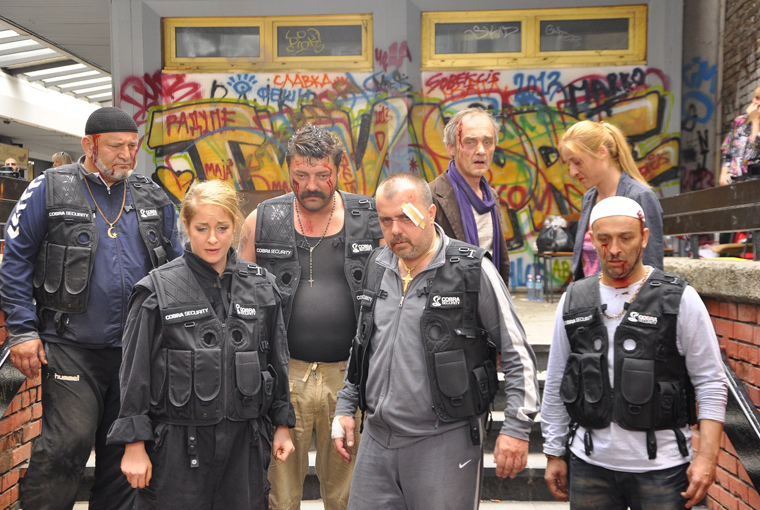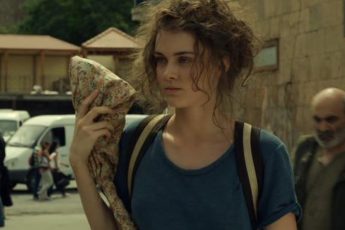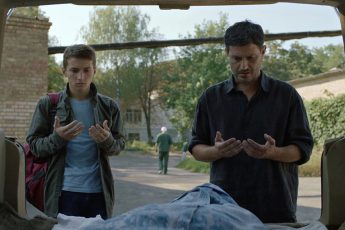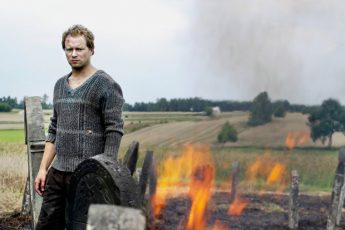Homophobic Violence and Kitsch: A Match Made in Serbia?
Srđan Dragojević’s The Parade (Parada, 2012)
Vol. 15 (March 2012) by Patricia Bass
Only six months ago, in late September 2011, the BBC reported that the Serbian government banned a gay pride parade in Belgrade. The year before, gangs of skinheads and christian fundamentalists were part of the several hundred protesters who threw petrol bombs, firecrackers, and rocks at the gay rights activists. By the end of the day, thousands of police had been mobilized to protect the parade, shots were fired, and cars overturned.
Who would have guessed that this 2010 human rights disaster would inspire a comedy-drama with the pace of Ace Ventura and poop jokes? Any one of the 800,000 Serbians who saw director Srđan Dragojević’s previous film Pretty Village, Pretty Flame (1996) about the Yugoslav wars, to name a few. In Pretty Flames, Dragojević mixed violence and dark humor in a way reminiscent of Apocalypse Now, but with a near-hipster aesthetic that either indicates American Apparel sponsorship, or a country stuck fashion-wise in 1982 (see film for handle-bar mustaches and neon sports shorts as evidence). Dragojević’s newest film, The Parade, uses the same kitsch aesthetic, adolescent jokes, and stereotype repertories to explore the 2010 Belgrade gay pride parade.
Called “fascist cinema” by Venice Film Festival director Gillo Pontecorvo, it’s easy to see why Pretty Flames and The Parade are susceptible to attack for complete lack of political correctness. In Pretty Flames, bullets are the punchlines to light jokes, and The Parade simplifies the Serbian LGBT movement to a war between ignorant catholic skinheads and feeble gay interior designers.
And indeed, it is simple. The Parade is simple in that it provides only the most basic of stereotypes for the gay and heterosexual characters alike. Representing Serbian homosexuals, the primary characters are a gay couple lacking anything resembling conventional virility: one loves animals, his messenger bag, and has a propensity to cry; the other, a theater-director-cum-marriage-planner, knows fashion and also…has a propensity to cry. The minor character of an older gay man is an interior designer, and the token lesbian is a blond nymphomaniac. Food for thought. At least the heteros are similarly one-sided: one Serbian ex-warlord who sprinkles his home with firearms and decorates only with war memorabilia, and his 7-foot-tall Viking queen, a blond with hair as long as the Dunav river, four inches of make-up, and bone-crushing heels.
Then, after about 50 minutes, one joke about shitting in a battlefield, two jokes about the nymphomaniac lesbian, and four “gay men crying” scenes later, things get more complex. Limun, the hetero warlord, finds himself on a road-trip with Radmilo, the gay veterinarian, visiting his war buddies in Bosnia, Croatia, and Kosovo. Very bluntly illustrating the irony of the ethnic rivalry underpinning the Yugoslav wars, Limun’s friends include a Bosnian Muslim, an Albanian from Kosovo, and a Croat. Their physically-intimate male bonding is playfully juxtaposed with Radmilo’s theory that Ben Hur is a homoerotic romance between warriors reunited. Limun seems to somewhat get the point. Radmilo is subsequently shown in the semi-virile position of doing dirty work (birthing a breached farm animal) that the other (homophobic) men are too squeamish to do.
You can see this ensemble of stereotypes and trite homilies as overly Western, overly ironic and thus overly detached. As was mentioned on this site vis à vis Kusturica’s Underground, turning Balkan social issues (homophobia, ethnic violence, etc) into cinema comedy can be comparable to the actual spectator role of Western countries during the Yugoslav wars: standing aside as they interpreted senseless tribal violence in the “spectacle” of ethnic bloodbaths.
However, unlike the controversial nature of a “distanced” political approach to Balkan conflict, a distanced cinematographic approach may be more productive than “Other”-ing. The films of Dragojević are parody: to take Hutcheon’s definition, a form of repetition with ironic critical distance1. Although this distance is, as we know, not always the most productively critical, note that a priori it has the ability to be.
For example, in regards to Balkan conflict, perhaps laughing at ethnic stereotypes is the only way to swallow the enormity of the violence and oppression of the Yugoslav wars. With regard to homophobic hate crimes, perhaps laughing at the messenger bag of an effeminate veterinarian is the only way to face the horror of a thousand-person public human rights violation. As Rilke eloquently puts it in Letters to a Young Poet, irony may be just another means to better understand life: “If you use it with pure intent, then it is pure.”
The “pure intent” of The Parade is accomplished via lessons tidy and quick, seemingly secondary to the blunt and often borderline humor, but they do the job. I can’t argue that it’s alright to reify the crassest of stereotypes, and perhaps for certain critical audiences, that is reason enough to bypass this film.
However, with all respect to those offended, The Parade is not a film made for them. The Parade is made for a public for whom such stereotypes will be less distancing and more associating, a public which Dragojević treats with both care and disdain: “I made a film for homophobes…” he states in one interview, rephrasing for the Berlinale, “it’s a simple film for decent people”. The value of his anti-homophobic dude film is just about as clear as his conflicting statements on those who he caters to.




slight factual correction: not Catholic, Orthodox christian
Using crass stereotype is a common device in Balkan cinema and TV. I think this is a brilliant movie in that it accomplishes the almost impossible. In a country where 5000 police were needed to protect 500 gay-pride marchers against 6000 thugs who came to kill, Dragojevic explains, and makes accessible the message: there’s no reason to hate homosexuals.
The primary target of this film is balkans homophobes, not gays living in liberal, western democracies.
A very strange movie to me. Probably intended for a Serbian audience. Humour is so thick and sickening that you can’t help thinking humiliating gay people is something that probably gives them a good laugh. Yet, they are shown in this movie as retarted people who still have a long way to go in terms of social progress. Very disturbing but I guess necessary to try to educate these people. So glad I was not born in that auwful country…